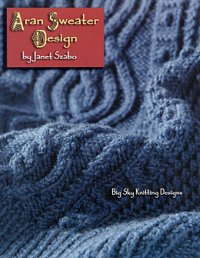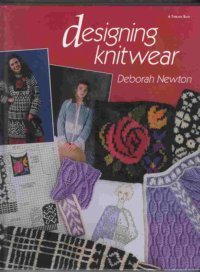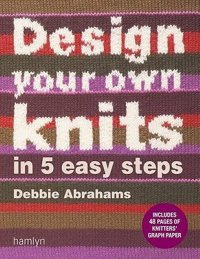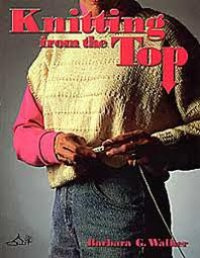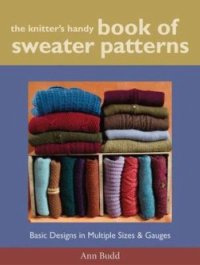This post contains affiliate links.
I’m sure my readers who primarily knit have been asking themselves, “When is our giveaway coming?” So today’s post is dedicated to all you knitters out there!
One of the reasons I retaught myself to knit was to take advantage of the many great books available to knitters on clothing and sweater design. For some reason, there are very few crochet books focused on sweater and clothing design. Since Lily Chin released Couture Crochet Workshop in 2006, I have seen a few crochet books here and there which talk about fitting and sweater or clothing design, but most of these books still emphasize pattern alteration rather+ than design from scratch. (I do hear that Custom Crocheted Sweaters: Make Garments that Really Fit
by Dora Ohrenstein, due out in January, 2012, will be awesome.) Since I started knitting again, I have slowly been collecting the various books that I’ve been hearing about from knitters about over the years.
I haven’t actually read these books, so I can’t give them a full review. But I have perused through them and can provide some descriptions. Eventually, I hope to read them all and apply my learnings to both knitting and crochet.
Aran Sweater Design by Janet Szabo
This book is organized into three sections. The first, “Aran Background and Fundamentals,” is a primer on Aran sweaters, various types of cables, different layouts, and knitting tips. The second, “Constructing an Aran,” reviews different construction and sleeve types including bottom up, top down, dropped shoulder, peasant sleeves, set-in s sleeves, raglan sleeves, vests, t-sleeves, and wide saddle. The last section, “Aran Sweater Projects,” includes patterns.
The book is mostly in black and white, with color photographs of the projects. There are knitting charts, many illustrations, and “decision points” in the steps of each of the construction methods. From the little that I’ve read, Szabo seems to write in a conversational tone, like a mentor explaining something to you. The retail price is $24.95 and it is available from Szabo’s Blue Sky Knitting as well as the major book retailers.
Designing Knitwear by Deborah Newton
I have the 1992 edition.
This book has eight chapters. “Learning to See” has some interesting photos of vintage knitwear. “Designing with Yarn” reviews properties of different yarns and seasonality, and provides tips on swatching, estimating yarn needs, and charting a pattern. “Fit & Silhouette” focuses on taking measurements, ease, and choosing structure, sleeves, and neckline. There are small sections on designing for a full figure and for maternity wear. “Designing with Knit & Purl” explores different patterned stitches, how to arrange repeats, and edgings and trims. “Color & Graphics” reviews different types of colorwork. “The Comfortable Classics” includes a gallery of classics (e.g., Chanel suit, Matador, etc.) and gives some sketching tips. “Themes & Samplers” has tips on slip stitch and twisted stitch patterns, cables, bobbles, eyelets and lace, motifs, and beaded and embroidered embellishments. “Dressmaker Details & Finishing” explores different silhouettes (e.g., trapeze, princess, etc.), shaping techniques, creating patterns, collars, lapels, pockets, cuffs, and finishing techniques.
This book looks like a textbook – my edition is hard cover and text heavy, with great historic photos and ample illustrations. Each chapter after “Learning to See” includes a section called “Swatch Project and Designer Notebook” and at least one garment pattern with a “What If…?” exploring different options. From looking through it, the book seems like a self-study/correspondence course with assignments that would turn you into a solid designer by the time you complete it. The 1998 edition retails at $24.95.
Design Your Own Knits in 5 Easy Steps by Debbie Abrahams
This book is organized into steps (as the title suggests). Step 1, “Inspiration, Stitches and Yarn,” emphasizes the personal nature of inspiration and includes photos of nature, a review of color and colorwork, different types of stitch textures, embellishments, and yarn. Step 2, “Ideas onto Paper,” focuses on using graph paper, gauge, scale, pattern repeats, converting measurements, and planning the design. Step 3, “Knitting a Swatch,” is all about the importance of swatching, gauge, and making adjustments. Step 4, “Mapping out the Design,” reviews body measurements, basic construction types, schematics, and measuring for accessories. Step 5, “Getting Knitting,” discusses the calculating yarn amounts, writing up your patterns, and different shapes (for scarves, blankets, cushions, bags, hats, socks, slipovers, sweaters, jackets/cardigans, and straight skirts), necklines, and collars. This section has instructions for each shape, neckline, and collar, written out in smaller font than the rest of the book, and sizing charts. The book also includes 48 pages of knitting graph paper.
This book is relatively light on text and has many vibrant and colorful pictures. It seems geared towards visual learners. The retail price is $17.95.
Knitting from the Top by Barbara G. Walker
The book is organized around 12 basic designs: Classic Raglan Pullover, Classic Raglan Cardigan, Seamless Cape, Seamless Skirt, Reversible Pants, Sleeveless Sweater, Seamless Set-In Sleeve, Seamless Saddle Shoulder, Kimono Sleeve, Square-Set or Peasant Sleeve, Dropped-Shoulder Ski Sweater, and Classic Cap.
There are a handful of black and white photographs but illustrations and schematics of each design. From the little I have read, the tone is very conversational. It seems like having a great teacher sitting next to you while you are working on a project. I especially like the “pause” and “continue” prompts at various points within each design. The book retails at $20 and can be purchased directly from Schoolhouse Press, as well as major book retailers.
The Knitter’s Handy Book of Sweater Patterns by Ann Budd
The subtitle of this book is “Basic Designs in Multiple Sizes and Gauges.” It’s basically a sweater recipe book. The designs included are Drop-Shoulder Sweaters, Modified Drop-Shoulder Sweaters, Set-In Sleeve Sweaters, Saddle-Shoulder Sweaters, Raglan Sweaters, and Seamless Yoke Sweaters. Each design includes guidelines for creating that style of sweater in child and adult sizes based on a stockinette gauge of 3-7 stitches/inch, and a cardigan variation. There are also tips for several variations of ribbing, necklines, edgings, and waist shaping throughout the book. There are some additional patterns (“copy cats”) in each chapter.
This book seems like the intermediary between following patterns and completely creating your own designs. It talks you through the number of stitches to cast on, when to shape armholes, sleeves, etc. But there is also design advice sprinkled throughout. It also has a great book design. It is a hardcover, spiral-bound book so it lays flat, and it includes an elastic marker to keep your place. There’s also a pocket in the back where presumably you would keep notes. There are many full color photos and each pattern sample is photographed on a model. The retail price is $26.95 and you can purchase it directly from Interweave Press or through other book retailers.
Sweater Design in Plain English by Maggie Righetti with Terri Shaw
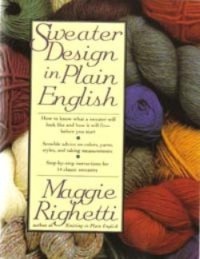
This book is organized into two parts. Part I, “Before You Begin,” covers yarn, body shapes, measurements (with very detailed and frequent illustrations), pattern stitches, color, estimating yarn, and gauge. There is a fair amount of discussion about the way in which the yarn, the stitches, and the design combine to flatter the wearer. For you math-phobic people out there, the book has a 14 page chapter called “Understanding the Arithmetic of Knitting.” Part 2, “Doing It – The Actual Designs,” includes chapters on different designs – The “T” Topper; The “Da Vinci Man” Sweater; The Puff-Sleeved Boatnecked Beauty; A V-Neck Pullover Vest; A Cabled, Classic, Crew-Necked Long-Sleeved Pullover; A Cardigan Jacket; A Child’s Raglan Turtleneck; A Timeless Adult Raglan Cardigan; All-in-One-Piece-from-the-Neck-Down-Pullover; A Coat of Many Colors; The True Batwing Sweater; Icelandic Yoked Pullover; Traditional Aran Fisherman Sweaters; and Diagonal Sweaters. There are additional chapters on sleeves, necklines and colors, and “interesting effects” like stripes, different colored cables, etc.
This book seems very informal (the sweater design names give a hint of that) and chatty, and there are some personal stories peppered throughout. It seems to have more information on the math than other books, even going so far as to include “fill in” problems. There are some black and white photographs and many illustrations. I’m not sure what is different in the new edition because I haven’t checked it out yet, but it retails at $24.95.
Sweater Workshop: Knit Creative, Seam-Free Sweaters on Your Own with Any Yarn by Jacqueline Fee

This book takes a different approach from the rest, by walking the reader through a sampler – basically a sleeve sized project that teaches many skills including different methods for casting on and binding off, stripes, short rows, button holes, increasing and decreasing, stripes, cables, pockets, and hems. The first section focuses on the sampler with illustrations, photos, and detailed directions. The next section, “Equip Yourself,” is all about yarn, needles, and other tools. The third section, “Unravel Your Thinking,” briefly explores construction and gauge. The fourth section, “The Basic Sweater,” walks through a sweater design adapted from Elizabeth Zimmerman. This section includes a formula page (“the Gauge Page”), which can be adapted for different gauges and measurements. The final section, “The Sweater Variations,” covers different necklines, cardigans, sleeves, and accessories.
The edition I have includes a small insert with color photos of completed projects and is spiral bound so it lays flat to allow reading and knitting. I would describe the writing style as casual instructional (e.g., “You will now be working back and forth on the needle”). I like the idea of the sampler since taking on a full sweater is a pretty large project if you don’t feel confident in the design and/or your skills. There are several newer editions, and I’m not sure how similar or different they are from my version. The second edition retails at $25.95 and can be purchased directly from Down East or through major book retailers.
What’s your favorite sweater/garment design book for knitting or crochet?
The Giveaway
Now that you are all fired up about designing that sweater you’ve always dreamed of…
Today’s giveaway is a knitting supply kit including:
One pair of Children’s Knitting Needles by Ponyin U.S. size 6 (4mm),
One set (5 pieces) of KA Classic Bamboo Double Point Knitting Needles, 6 Inch (15 cm) in U.S. size 6 (4.25 mm),One set of KA Classic Bamboo Circular Knitting Needle, 16 Inch (40 cm) in U.S. size 7 (4.5 mm),One set of Boye Plastic Curved Cable Stitch Needles 3pc, and
One set of KA single point straight bamboo knitting needles, 9″ (23 cm) in U.S. size 7 (4.5 mm).
All items in the kit are brand new in their original packages.

